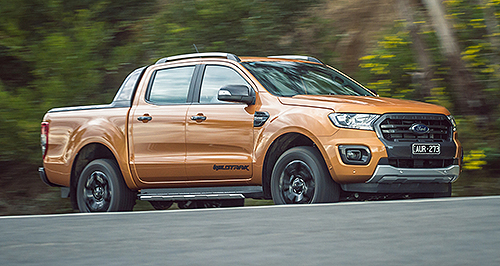Make / Model Search
News - General News - SalesPrice pressure builds as AUD plummetsHow far: Popular vehicles such as the Thai-built Ford Ranger face price pressure as the Australian dollar slides against major currencies. Australian car companies caught between higher import costs and flagging sales7 Aug 2019 AUSTRALIAN car buyers face price rises on new vehicles unless the relentless slide of the Australian dollar is reversed – and soon.
The AUD dipped to a 10-year low against the United States dollar this week after Australia was again caught in the crossfire of the US trade war with China.
The Australian currency has now been devalued by up to 30 per cent against major currencies such as the US dollar and Japanese yen since about 2014.
Australian car distributors are now caught in a pincer between the higher cost of imported vehicles and softening sales demand in the showrooms, where sales volume has fallen by 7.7 per cent this year after running at record or near-record levels for several years.
Many companies have already been easing prices up this year, especially with the arrival of new models, but most have been loath to move too quickly lest sales suffer in a tight competitive situation.
Record-low interest rates have helped to limit the sales decline to date, especially in July when sales dipped just 2.8 per cent compared with the same month last year.
But the AUD fell to a 10-year low of 67 US cents on Wednesday because of Australia’s trade exposure to the Chinese market – a major buyer of Australian commodities.
A similar impact has been felt against currencies of all major countries that supply motor vehicles to Australia.
Japan, which supplies almost a third of all vehicles sold in Australia, has watched its yen go from 100 to the AUD in 2015 to 71 now – a 30 per cent strengthening in a relatively gradual process.
With most Japanese car importers working to a target yen exchange rate of about 80 to the AUD, many local teams are now burning the midnight oil to come up with strategies to get back into the black should the rate stay in the 70s beyond the next month or so.
The currency of Thailand, now the second biggest exporter of vehicles to Australia and source of top sellers such as the Toyota HiLux and Ford Ranger, has gone from 29.68 baht to the AUD four years ago, to 20.61 this week – a 30 per cent escalation.
The Korean manufacturers Hyundai and Kia have fared better than most with the won strengthening about 16 per cent against the AUD since 2014, while the European Euro has gone from a recent peak of 72.8 per cent at the end of 2016 to 59.6 to the AUD – a 17 per cent change.
And despite the recent devaluation of the yuan by the Chinese government, the yuan is still 18.3 per cent stronger to the AUD since a high of 5.77 in 2014.
For importers of Chinese vehicles in Australia, the problem gets a little more complicated as many buy their shipments in US dollars – and who knows where that currency is going to go against the yuan in the current trade war.
The good news for vehicle importers is that everyone is in much the same boat – their landed costs are more expensive now – and so it could be a matter of whom can stand the most pain the longest.
The other good news is that the devaluation of the AUD should make Australia’s car parts industry and vehicle development operations more competitive.
Theoretically, Ford, Holden and Nissan will be among the winners. Ford Asia Pacific runs the nation’s biggest design and engineering operation out of Melbourne, funded out of Detroit, while Holden also has a major presence with GM Design Australia and GM engineering working on global projects in Victoria.
Nissan’s Dandenong South casting plant – supplier of many aluminium components for vehicles such as the Nissan Leaf – is also looking more secure as the AUD drops.  |
Click to shareGeneral News articlesResearch General News Motor industry news |









Facebook Twitter Instagram